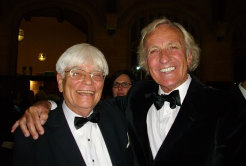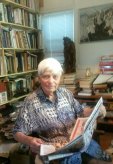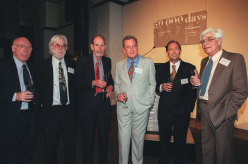
David Noel Bowman was born in Adelaide on February 19, 1930. He was educated at Pulteney Grammar School and Norwood High. A passion for chess – he won the South Australian schoolboy championship in 1945 and the state open title in 1947, 1948 and 1951 – led him to journalism.

Former SMH editor David Bowman and journalist John Pilger at the Sydney Peace Prize, 2009.
In the late 1940s, he was a junior draftsman with the South Australian Highways Department, while studying engineering part-time. The State Library lay on his walk to university and often he would skip lectures to read chess books instead. Putting aside his studies, he sent chess reports to The News, which offered him a job as a copy boy, then journalism’s lowest rung. At 19, he was a cadet journalist, and in his early twenties, he followed many of his generation overseas.
In London, he was hired by the Junior Mirror, where a budding career was interrupted by an offer to crew on a motorboat said to be on an epic mission to find the wreck of the General Grant [a 1005-ton three-masted bark built in Maine in the United States in 1864] off the coast of New Zealand. The boat hit a reef near the Red Sea, keeled over and the crew were rescued by a Sudanese camel herdsman. “Junior Mirror Man in Red Sea Drama”, declared his paper’s front page. David Bowman never failed to relate this without the mischievous laugh that was characteristic.
Back in Adelaide, his career prospered under the crusading editorship of Rohan Rivett, who sent him to Canberra in a relieving role in 1957, then in 1960 as political correspondent. Bowman rebelled against the merger of the Canberra bureaus of The News and the tabloid Sydney Daily Mirror but agreed to stay on as assistant editor of the Sunday Mirror, even enjoying what he called “the larrikin freedom” of a pop Sunday tabloid, When Arthur Shakespeare, chairman of The Canberra Times, invited him to be editor in 1962, he leapt at it.
With a shock of grey hair at 32, Bowman applied stamina, resourcefulness, and infinite attention to detail in lifting the quality and horizons of a thinly staffed paper still shaking off the provincialism of Canberra’s bush capital days. He set himself a pattern of 14- to 16-hour days to be followed for the next 18 years.

David Bowman former Herald editor in 2016.
He stayed as editor when Fairfax bought The Canberra Times in 1964, appointing John Pringle over him as managing editor, and poured in staff and resources to fight off Rupert Murdoch’s new Canberra-based daily, The Australian. They became a formidable team.
Pringle’s description of Bowman in Canberra as they battled The Australian gives a sense of Bowman’s commitment to the journalism he loved: “David Bowman, a journalist of far greater technical skill than I and a young man of extraordinary drive and energy ... would be sitting at his desk when I arrived at 11 in the morning and would still be there, subbing copy, reading proofs, making up pages, when I left in the bitter frost of a winter’s night at 1 or 2 in the morning.“
Pringle departed for Sydney to edit the Herald in 1965 and Bowman followed in 1968 as executive assistant. When Pringle left the Herald in 1970, Bowman was named news editor and brought the energy Pringle had described. Whatever the hour, when he walked the editorial floor it was as if late for an appointment, tie tossed back, hair unruly, face set in concentration. His memos to staff became famous. These lucid, direct, even graceful messages of encouragement, advice or rebuke flowed copiously, earning him the nickname Captain Memo.
With some staff he communicated better in writing than face to face and at times his impatience with incomplete or careless work showed. He also displayed warmth and wit in conversation, broad interests despite his regime of self-imprisonment, a readiness to quote poetry. No longer addicted to chess, he would occasionally play Scrabble at weekends, giving no quarter and using a chess clock to cram each game into an hour. He loved the bush and on annual leave he and his family would tour remote districts with a tent and Scrabble set.
Bowman moved in 1973 to a newly created post, executive editor, responsible for the content of all Fairfax Sydney papers except editorials in the Herald, The Australian Financial Review and The National Times. It was not a job he sought. He did not believe editors should look over the shoulders of editors, and those he supervised were jealous defenders of their authority. There was notable conflict with two of the toughest, Vic Carroll, managing editor of The National Times, and Max Suich, the Times editor.
In 1977, concerned about circulation, the Fairfax board appointed Bowman editor-in-chief of the Herald. He lost no time. Widespread changes gave new prominence to finance and the arts, more than doubled the space for readers’ letters and enlarged the Saturday magazine.

Former Fairfax editors (from left) Max Suich, Max Prisk, John Douglas Pringle, James Fairfax, Chris Anderson and David Bowman.Credit:Peter Rae
With authority over editorials for the first time, he turned back the rigid conservatism that often marked the traditional Herald and sought to revive even-handedness, reflecting liberal political and social attitudes.
Circulation remained stagnant, however, and began to slide again after a price rise in 1980. In a move worthy of Bowman’s beloved chess, Suich became chief editorial executive in July 1980 and in a few months had delivered to Bowman the board’s abrupt notice of dismissal. Carroll succeeded Bowman; and from the outside, Bowman was to watch ruefully, and with some admiration, as Carroll, with a staff increased by half, made spectacular changes.
In The Captive Press, Bowman wrote of the obstacles to change he faced at the Herald. He admitted: “A bolder, braver editor-in-chief might have crashed through these institutional barriers; I could not.”
On leaving the Herald he chose permanent exile; he did not respond to a subsequent overture from Fairfax. Robert Holmes a Court offered him an editorship in Perth, which he declined, having been refused an editor’s “rudimentary rights”. He embraced a new career as an essayist and commentator.
He wrote press criticism for Australian Society, the Adelaide Review, the Sydney Review, and 24 Hours, the ABC’s radio magazine. At the London Daily Telegraph, his Australian obituaries were much admired. His spare, eloquent style used irony and wit in what was often powerful political writing of a kind seldom seen or welcomed in the Australian mainstream.
His hatred of injustice and bigotry was often in evidence. He championed political dissidence and those whose voices he felt were not being heard, such as the Palestinians. He was working on a biography of Allan Ashbolt, the renowned broadcaster once described as “the ABC’s conscience-in-residence”, when he first fell ill.
He was married for 27 years to Adelaide-born Elizabeth Patricia Tighe, with whom he had two children, Stephen and Robyn. They divorced in 1981. His second wife, the former Margaret Shev, survives him.
Alan Dobbyn (who died in 2015)






 Add Category
Add Category